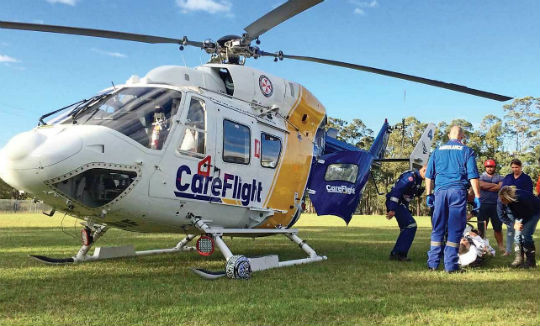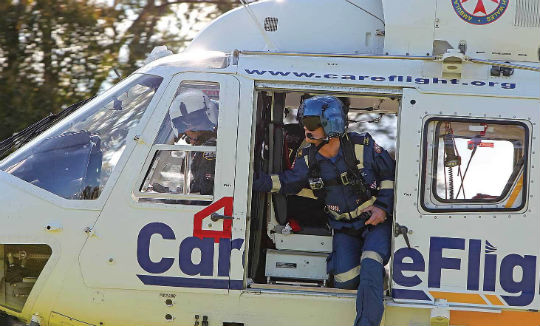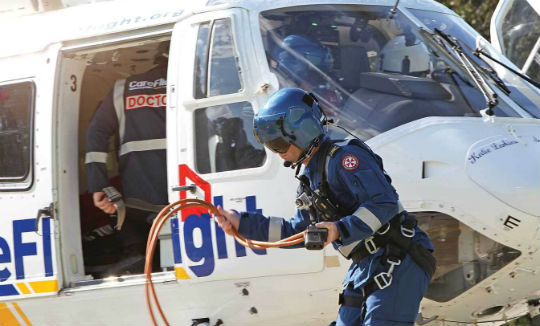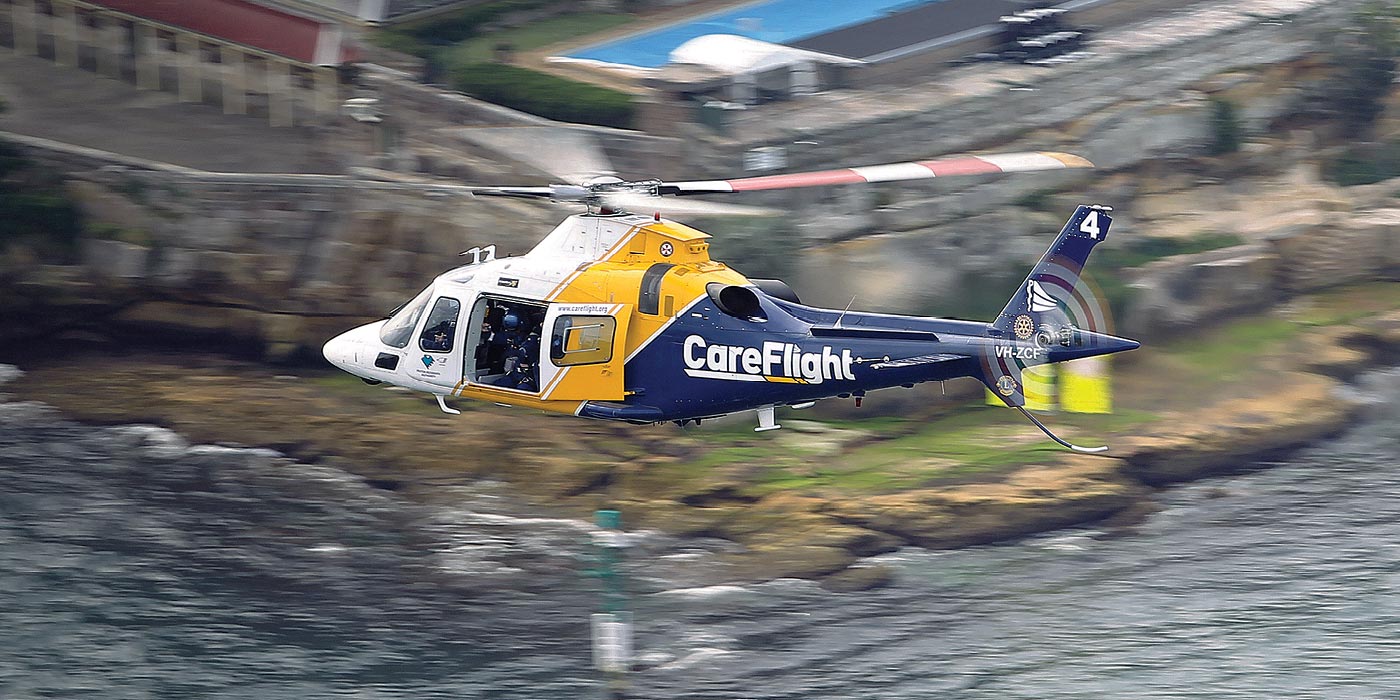
Once the world’s fastest-responding helicopter air ambulance service, Sydney, Australia-based CareFlight continues to deliver its medical team to the side of a critically injured patient anywhere within the greater Sydney basin in an average time of just 18 minutes, responding from the moment a “triple zero” emergency call is made.
Such a rapid response is no mean feat given the complexity of Sydney’s busy civil and military airspace, congested road network, and the expanding suburban topography of its growing population — which has now reached over five million.
As Australia’s only dedicated rapid response medical helicopter, CareFlight celebrated the service’s 10th anniversary in April 2015, marking a decade of decreasing the mortality and improving the outcomes of over 2,500 seriously injured patients by operating its helicopter in a specialized way.
The service began as a clinical trial in April 2005, running independently of CareFlight’s helicopter emergency medical services (HEMS) contract with New South Wales Health. Called the Head Injury Retrieval Trial (HIRT), it was set up to investigate the influence of early physician intervention in cases of serious head trauma in the urban area within 20 minutes of a triple zero emergency call (the Australian equivalent of North America’s 9-1-1).
CareFlight’s then medical director, Dr. Alan Garner, OAM, looked into the rates of intervention performed by CareFlight’s doctors on board its HEMS helicopter, which commenced operations in July 1986, and compared them against road-based ambulance paramedics during the late 1990s. “The rate of intervention for severely injured patients was quite different and the obvious question was, did this make a difference to outcome?” said Garner, who was awarded an Order of Australia medal in 2007 for service to emergency, disaster, and retrieval medicine. “We collected data on a group of patients we had treated and compared this with a group of patients road paramedics had treated. There did in fact appear to be a difference, but the data was not high-quality because it was retrospective in terms of scientific methodology. The Head Injury Retrieval Trial was an attempt to get some high-level scientific data to support that that was actually true.”

Garner approached CareFlight co-founder and then CEO Ian Badham, OAM, with an idea for a research project. “From the time he came to me until the time we started HIRT was six-and-a-half-years,” said Badham, who also founded the country’s first civil surf rescue helicopter service in 1973. “Before we could start the trial, Dr. Garner had to obtain ethics approvals from 13 separate entities, get permission from the health authorities, and then there was the small matter of securing $11.2 million to fund it. This gives you a scale of what was involved.”
Up and running
Using a dedicated AgustaWestland AW109E Power for the trial, call signed “CareFlight 4,” the aim for CareFlight was to be airborne in three minutes from identifying a randomized trauma case. It would fly a specialist trauma doctor and a senior Ambulance New South Wales (ANSW) paramedic from its base at Westmead Hospital, in Sydney’s growing western suburbs, to an accident scene within its 63-nautical-mile service radius, by day and under visual flight rules (VFR) conditions.
From the Central Coast to the north, west, and south, CareFlight used the Power’s compact 11-meter (36-foot) rotor diameter to its advantage to land as close to the incident scene as possible. “From the time of the triple zero call starts, where we [knew] absolutely nothing about the job, until the time we touched the patient averaged 18 minutes anywhere in the Sydney basin,” said Garner. “Often we’re faster than that, but the further out we [went], the closer we got to the 18-minute mark.”
To Garner, the helicopter was simply a means to an end, as the trial needed to get a medical team to a patient as rapidly as possible. “Specialization versus generalization means that you will do the specialist role really well, but you might not be able to perform some of the other roles,” said Garner. “We were not pretending that we could fly 100 nautical miles off the coast to winch someone off a boat — we didn’t even have a hoist. Having a hoist on the helicopter was just going to complicate our operations and we looked at this when we started the trial. The number of cases where we needed a hoist was quite small, so we thought it was better off leaving hoist responses to the existing helicopter retrieval services to ensure that our service, for the other 99.99 percent of cases, was really fast.”

Fast to launch and fast to get to the patient, the HIRT team was also fast while on scene. The time CareFlight’s retrieval specialists spent roadside administering care before transporting the patient to hospital was the fastest. “We tweaked a whole lot of other components of our system from a medical point of view so our scene times were, as far as we could tell by comparing ourselves with published data, the fastest service in the world.”
Getting the results
In March 2011, after realizing they were not going to be able to meet their targeted number of patients for the trial, the CareFlight team recruited their last patient and began examining the data. Over the six-year period, CareFlight’s HIRT team responded to around 1,500 patients, with the majority of these involved in motor vehicle accidents. The results indicated that unconscious patients treated by doctors had lower mortality, and Garner was satisfied he had demonstrated that what CareFlight was doing did make a difference to patient outcomes.
Garner announced the results of the HIRT at the 2012 International Conference for Emergency Medicine in Dublin, Ireland. “We saw a 16 percent absolute reduction in mortality in unconscious patients that were treated by doctors,” he said. “We contributed to reducing the length of stay in the intensive care unit for all severe head injury patients by 30 percent. We were airborne 17 minutes faster and delivered patients to hospital 40 percent faster than comparable helicopter services. The system was unique in the world and the data indicated we were the fastest in the world.”
There had never been an equivalent trial to the HIRT done anywhere in the world, although the operational model used for getting the HIRT team airborne in three minutes was modeled closely on Germany’s ADAC service. “This was unheard of in Australia,” said Garner. “When we took the concept to Ambulance, their view was you could not get a helicopter to a patient in an urban area of Sydney in anything less than half an hour. A lot of people were very surprised that we were turning up either at the same time as the road ambulance or just shortly thereafter, long before the paramedics were able to remove the patient from the scene. There was just no knowledge this was possible in this country from an operational point of view.”

CareFlight had direct access to the ANSW computer dispatch system and made its own decision whether to respond if the patient’s injuries met their criteria of the HIRT. (Of note, during the trial CareFlight responded to all incidents involving a pediatric patient, but these cases were not included in the HIRT analysis.) “From the time when the triple zero call started with the ambulance operator entering the details of the emergency into the computer-aided dispatch system, to the time we lifted off the helipad and [were] on our way, was consistently six minutes,” said Garner. “That six minutes included identifying the case and possibly calling them back to get further information to see if the patient qualified for inclusion in the trial. The pilot would realize a call could become a case and would go and sit in the helicopter ready to start.”After the trial was completed, access to the ambulance computer dispatch system for self-tasking was removed. There was a lot of uncertainty as to the future of CareFlight. With its HEMS contract not renewed in 2006, CareFlight continues today with its rapid response service as an independently funded add-on to the state’s retrieval system. It uses a BK117 B1, VH-BIF, call signed “CareFlight 4,” and works under a formal agreement with ANSW as the operating agency of NSW Health.“The ANSW has established a rapid launch trauma coordinator (RLTC) position to look at the dispatch screens to recognize serious trauma accidents and to task helicopters accordingly,” said Badham. “We continue to do some good work and more recently, over the past 12 months, the way in which Ambulance has used the rapid response capability has actually increased,” Badham continued. “We have been tasked to 251 missions in the eight months to Feb. 24, 2015, of financial year 2014-15. This represents a 37 percent increase on the same period in 2014. So, it has been an education and a learning process from both sides. Ambulance NSW have become much more adapted and the RLTC are quickly sending us to the right jobs.”
Into the unknown
Operating 12 hours a day, unless limited by darkness, CareFlight rarely does inter-hospital transfers, with almost every single mission a launch into the unknown. Averaging one mission per day, the weekends are the busiest for responses, but that is a standard trend with most pre-hospital HEMS. All of CareFlight’s rapid response missions are primary scene missions, as was the case during the HIRT. CareFlight’s founding chief pilot and now line pilot, John Hoad, noted that the HIRT had a clearly defined area of operation, which allowed crews to pre-plan for the type of missions within their scope of operations. “We always had a standard fuel load that would be adequate for our radius of operation,” said Hoad. “Our configuration was fixed, the weather conditions under which we would operate [were] fixed, and so when the phone rang, you have done everything as far as planning was concerned. The only thing you needed to know was where you were going.”

CareFlight’s ability to get airborne quickly is a function of the way it has set up its processes. During the HIRT, CareFlight crews rehearsed their walk to the helipad in detail. They trialed various aspects of their operations — from having different medical equipment ready in the helicopter, to keeping their helmets on different sides of their ready room — so that every spare second could be gained. “We don’t rush, but we do things efficiently and that efficiency results in an outcome which is a rapid response,” said Hoad. “When the phone rings, everybody knows exactly what they are going to do. I don’t take the details of the call, I instead grab my helmet and kneeboard and go straight out to the helicopter and start up. The paramedic follows me out and is there to provide fire guard during start.”A swift response
CareFlight crews — which consist of a pilot and aircrewman up front, and a doctor and paramedic in the cabin — have a very reliable method of making sure they can navigate to any location as quickly and efficiently as possible. Both the aircrewman and doctor listen in to the call and independently take down the details to mitigate the likelihood of mishearing or writing down incorrect information. The aircrewman will enter the location into a moving map display on a ToughBook, which then generates a distance and bearing from Westmead. If the mission will take the helicopter into controlled airspace, the crewman will speed-dial the traffic manager at Airservices Terminal Control Unit at Sydney Airport and pass on the distance, bearing, and suburb details.
The air traffic management system uses this information to automatically generate a transponder code for CareFlight without the need of putting in a full flight plan. Air traffic controllers can then plot exactly where CareFlight is headed and will expect to see them on their radar screen in a matter of minutes.
Should the information suggest the landing site would likely prohibit the medical crew from walking directly to the scene, the crewman will also call the police and alert them of the mission. A police car will then be dispatched to meet the helicopter and drive the medical crew the remaining distance to the patient.

Once on board, the doctor shares the details of the mission with the paramedic in the rear cabin. “Because some of our taskings require very little flying time, and with some into controlled airspace where I’m very busy talking to air traffic control, by the medical crew having the details of the job cuts down the need for the rear cabin to talk with us up in the front,” said Hoad.Vertical 911 witnessed CareFlight’s swift response first hand. While conducting this interview with Hoad, an emergency call came through to its Westmead base. From the very first ring of the phone until Hoad lifted the skids of CareFlight 4 off the pad was four minutes and 45 seconds. CareFlight 4 climbed away en route, responding to a pediatric patient in cardiac arrest in a remote area of the lower Blue Mountains, around 60 kilometers (37 miles) to the west of Sydney.
“With the BK117, if we were operating in a very cold environment we would have to wait for the oils to come up to temperature before we could get airborne,” said Hoad. “In Australian conditions, basically as fast as you can complete your start up and before takeoff checks, the temperatures are in the green and you are ready to get airborne.”
CareFlight carries a minimum standard fuel load of 380 kilograms (838 pounds) that allows the BK to fly to a radius of up to 68 nm from Westmead. “When the weather is not so good, we bring that down to 50 nm which, under VFR conditions by day, there is no requirement to provide an alternate,” said Hoad. “This really simplifies flight planning considerations. Because Sydney is geographically in a basin, with higher ground to the north, west, and south, when the weather is bad you naturally get restricted to the basin area.”
Australia’s helicopter landing standards are based on a Civil Aviation Safety Authority (CASA) advisory circular with a basic helipad needing to be large enough for the pilot to believe they can land safely by day. Because HEMS is categorized under aerial work operations, CareFlight does not have single-engine accountability standards for going into unimproved helipads. “The main consideration for us, and for all pilots, is the presence of wires,” said Hoad. “You have to be able to make an assessment quite quickly whether or not you are going to cause too much disruption with rotor wash when landing in some locations.”

When deciding whether to land in a cul-de-sac or a road intersection — which might be closer to the patient but is likely to be surrounded by wires — Hoad will always prefer a large open area such as a sports oval, even though it might be a kilometer from the scene. “You can spend quite a bit of time assessing the safety of landing in a very confined spot,” said Hoad. “Even if you can assess the spot quickly, to do an approach with a vertical descent, it always has to be done slowly and carefully. If you rushed in there with a fast rate of descent and there was an unforeseen problem where you need to pull out, it becomes more difficult to arrest the descent and get back into a positive rate of climb. With a larger area, the assessment of safety can be made more quickly and you can pretty much go straight in and your recce can be done on final with wires always as your top priority with any area you are going to land at.”
Peak hour in Sydney cannot afford any more traffic chaos than is necessary. And CareFlight is very aware of that, rarely landing on a main road and staying there. “We generally drop the medical crew off and then get airborne to reposition,” said Hoad. “When you see pictures of us landed in a cul-de-sac or on the highway it’s because more than likely there was no other more suitable location to land at — it was the best choice.”
As a large portion of CareFlight’s responses are within the metropolitan area with several trauma hospitals near by, the medical crew will only choose to fly a patient to hospital if the journey by road ambulance will exceed more than 30 minutes. During the trial, CareFlight only flew about 20 percent of cases to hospital. “If you are going by air, first you have to load the patient into an ambulance and drive a short distance to the helicopter, that’s assuming we were not able to land at the scene,” said Hoad. “Then, you have to off-load them from the ambulance and re-load them into the helicopter, which involves changing stretchers. The flight is quicker than driving, but once we land and have shut down, again we un-load them on to the hospital’s gurney. At a majority of the hospitals we go to, getting from the helipad into the ED [emergency department] is a long way, usually with a ride in an elevator. Going by ambulance, the patients are loaded in and can be driven under lights and siren all the way there. On arrival, the ambulance reverses up into the receiving bay [and] off-loads the patient, who is then wheeled virtually straight into the ED.
“For the trial, everything was about, how does this affect the outcome of what we are trying to do. That caused us to look at the logistics without the bias of ‘we are always going to take the patient by helicopter.’ The helicopter is a really good tool for getting the medical team to the patient very quickly. How the patient then got to the hospital became less important.”
Compared with the AW109E Power, the BK117 has about the same footprint and is well suited to what CareFlight does. “What I liked about the Power was its FADEC [full authority digital engine control] and it was very quick to start and shut down,” said Hoad. “It has a very effective rotor brake so not only could you stop the engines after 30 seconds, but the rotor brake got the rotors stopped quite quickly.”

Cruising at about 150 knots, the Power’s speed advantage was negligible compared to the BK117’s 125 knots over the shorter-distance jobs — though it is not called the Power for nothing. At maximum gross weight it performed very well, even with one engine inoperative. “A good power margin is a safety benefit particularly if you are going into confined areas,” said Hoad. “They both have pluses and minuses. In a patient transport and loading point of view, I prefer the BK. Plus its tail rotor is up high on a pylon, which increases safety.”
Teddy bear funded
Currently reviewing its future helicopter needs, CareFlight will need to ensure it meets elevated helipad Cat A and Performance Class 1 regulations, which CASA plans to bring into effect soon for air medical operations. However, a new helicopter will come at a price. “There is no perfect helicopter for this role,” said Garner. “But we do need a smaller aircraft in this operation and not an AW139 like everyone else, because 6.8 tonnes of rotor wash when you are trying to land in a car park is not a great option. Sure, an [Airbus Helicopters] H145 would suit us down to the ground, but that’s a lot of fundraising that we would have to do.”
Unlike other HEMS operations in Australia, for which government funding contributes most or all of the annual running costs, CareFlight’s rapid response service relies totally on corporate sponsorships and community donations. “We are fortunate the community understands what we do,” said Badham. “The fact that people do support us in the way that they do is a testimony to a community’s appreciation of what CareFlight and Australian aeromedical services across the board bring to a community.”
Focusing on major trauma in the urban area, CareFlight’s rapid response service is about taking the hospital to the patient. Getting a senior doctor with focused trauma experience, equipment, and a paramedic to the scene rapidly does make a difference to the outcome of patients with severe injury. And CareFlight has the evidence to prove it.
A version of this story originally appeared in Australian Aviation.






